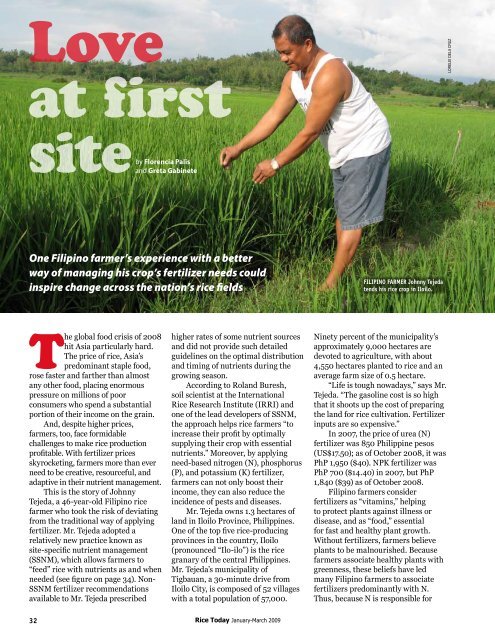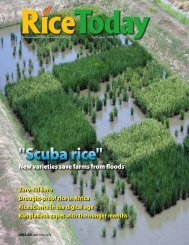Loveat firstLorelei dela Cruzsiteby Florencia Palisand Greta GabineteOne Filipino farmer’s experience with a betterway of managing his crop’s fertilizer <strong>need</strong>s couldinspire change across the nation’s <strong>rice</strong> fieldsFILIPINO FARMER Johnny Tejedatends his <strong>rice</strong> crop in Iloilo.The global food crisis of 2008hit Asia particularly hard.The p<strong>rice</strong> of <strong>rice</strong>, Asia’spredominant staple food,rose faster and farther than almostany other food, placing enormouspressure on millions of poorconsumers who spend a substantialportion of their income on the grain.And, despite higher p<strong>rice</strong>s,farmers, too, face formidablechallenges to make <strong>rice</strong> productionprofitable. With fertilizer p<strong>rice</strong>sskyrocketing, farmers more than ever<strong>need</strong> to be creative, resourceful, andadaptive in their nutrient management.This is the story of JohnnyTejeda, a 46-year-old Filipino <strong>rice</strong>farmer who took the risk of deviatingfrom the traditional way of applyingfertilizer. Mr. Tejeda adopted arelatively new practice known assite-specific nutrient management(SSNM), which allows farmers to“feed” <strong>rice</strong> with nutrients as and when<strong>need</strong>ed (see figure on page 34). Non-SSNM fertilizer recommendationsavailable to Mr. Tejeda prescribedhigher rates of some nutrient sourcesand did not provide such detailedguidelines on the optimal distributionand timing of nutrients during thegrowing season.According to Roland Buresh,soil scientist at the InternationalRice Research Institute (IRRI) andone of the lead developers of SSNM,the approach helps <strong>rice</strong> farmers “toincrease their profit by optimallysupplying their crop with essentialnutrients.” Moreover, by applying<strong>need</strong>-based nitrogen (N), phosphorus(P), and potassium (K) fertilizer,farmers can not only boost theirincome, they can also reduce theincidence of pests and diseases.Mr. Tejeda owns 1.3 hectares ofland in Iloilo Province, Philippines.One of the top five <strong>rice</strong>-producingprovinces in the country, Iloilo(pronounced “Ilo-ilo”) is the <strong>rice</strong>granary of the central Philippines.Mr. Tejeda’s municipality ofTigbauan, a 30-minute drive fromIloilo City, is composed of 52 villageswith a total population of 57,000.Ninety percent of the municipality’sapproximately 9,000 hectares aredevoted to agriculture, with about4,550 hectares planted to <strong>rice</strong> and anaverage farm size of 0.5 hectare.“Life is tough nowadays,” says Mr.Tejeda. “The gasoline cost is so highthat it shoots up the cost of preparingthe land for <strong>rice</strong> cultivation. Fertilizerinputs are so expensive.”In 2007, the p<strong>rice</strong> of urea (N)fertilizer was 850 Philippine pesos(US$17.50); as of October 2008, it wasPhP 1,950 ($40). NPK fertilizer wasPhP 700 ($14.40) in 2007, but PhP1,840 ($39) as of October 2008.Filipino farmers considerfertilizers as “vitamins,” helpingto protect plants against illness ordisease, and as “food,” essentialfor fast and healthy plant growth.Without fertilizers, farmers believeplants to be malnourished. Becausefarmers associate healthy plants withgreenness, these beliefs have ledmany Filipino farmers to associatefertilizers predominantly with N.Thus, because N is responsible for32 Rice Today January-March 2009
Amount of fertilizer applied (in bags per hectare and kg of nutrient per hectare) before and after use ofSSNM by Johnny Tejeda, 2007 wet season. DAS = days after sowing.Number of bags per hectare per applicationBefore ssnmafter SSNM1st 2nd Total 1st 2nd 3rd Total(20 DAS) (40 DAS) bags (12 DAS) (28 DAS) (38 DAS) bagsUrea 2 2 4 0 1.5 1.5 314-14-14* 1 1 2 3 0 0 3Total bags applied 3 3 6 3 1.5 1.5 6Amount of nutrients per application, kg per hectareBefore ssnmafter SSNM1st 2nd Total 1st 2nd 3rd Total(20 DAS) (40 DAS) nutrients (12 DAS) (28 DAS) (38 DAS) nutrientsN 53 53 106 21 35 35 91P 2 O 5 7 7 14 21 0 0 21K 2 O 7 7 14 21 0 0 21*14-14-14 is a typical NPK fertilizer used in the Philippines.a <strong>rice</strong> plant’s greenness, farmersoften give extra attention to ureaapplications.Direct sowing of <strong>rice</strong> seed, ratherthan transplanting of seedlings, iscommon in Iloilo. Planting time forthe wet season is usually in May–July,depending on adequate rainfall, andharvest is in August–October. The dryseason is from October–November toFebruary–March.In May 2007, IRRI scientistsled by Dr. Buresh in collaborationwith Greta Gabinete, a soil scientistat West Visayas State University inIloilo, established a small SSNMdemonstration in Mr. Tejeda’s and aneighboring <strong>rice</strong> field. The neighboringfarmer, who was also an agriculturaltechnician, told Mr. Tejeda that SSNMvalidation experiments had worked inother villages. While the experimentwas being conducted, recountsMr. Tejeda, he quietly imitated theSSNM practice on the remaining 1.2hectares of his field. It was a risk, but,he decided, one worth taking giventhe rising p<strong>rice</strong>s of fertilizers and theincreasing cost of living.Like most Iloilo farmers, Mr.Tejeda used to apply fertilizer twiceper season, at 20 and 40 days aftersowing (DAS) in both the wet andthe dry season. Per hectare, he wouldapply two 50-kg bags of urea (eachbag contains 23 kg N) and one 50-kgbag of 14-14-14 NPK (containing 7kg each of N, P 2 O 5 , and K 2 O; this isa typical NPK fertilizer used in thePhilippines) at both 20 DAS and 40DAS, giving a per-hectare total of106 kg N, 14 kg P 2 O 5 , and 14 kg K 2 O.His normal yield in each season was4–5 tons per hectare of unmilled <strong>rice</strong>grain (at 14% moisture content).“SSNM has really helped mea lot,” says Mr. Tejeda. “When Ipracticed SSNM in the 2007 wetand dry seasons, my yield increasedmarkedly. Since then, I havecontinued practicing SSNM.”The increase in yield was verifiedby a field technician who harvestedgrain from Mr. Tejeda’s crop in bothseasons. The wet-season yield ofair-dried, unmilled grain increasedfrom 4.1 tons per hectare with theoriginal fertilizer practice to 6 tonsper hectare with SSNM. In the dryseason, the yield rose from 4.6 to 6.5tons per hectare.With SSNM, Mr. Tejeda appliedfertilizer three times, instead ofhis usual two applications. His firstapplication was at 12 DAS using threebags of 14-14-14 NPK. His secondand third applications were at 28 and38 DAS using 1.5 bags of urea perhectare for each application. Beforeand during SSNM, he used a total ofsix bags of fertilizer per hectare, butthe nutrient composition and timingof the applications differed (see table,left).It is instructive to hear what Mr.Tejeda has to say about SSNM in hisown words.When I first practicedSSNM in the 2007 wet season,I couldn’t sleep well for around10 days after my first fertilizerapplication. My <strong>rice</strong> plantsweren’t green and they were notgrowing well compared withthose in other farmers’ fields,though the growth and color ofthe leaves were similar to thosein the neighboring SSNM demoplot and the experimental plotin my field. Before I slept, I keptwondering why it seemed thatthere was no fertilizer responseby my <strong>rice</strong> crop. I was reallyanxious that my crop might fail.For those 10 days, I was uneasyand kept moving around the <strong>rice</strong>fields in the village, comparingthe growth of the <strong>rice</strong> plants.clydie p. pasiaRice Today January-March 200933

















